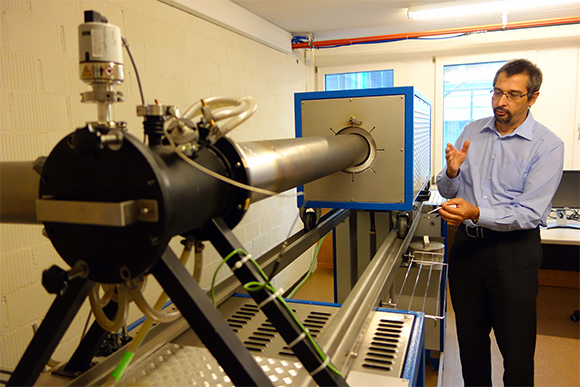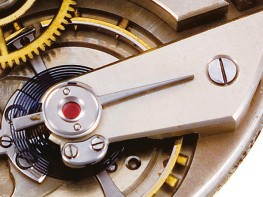There is a certain irony in the fact that the quasi-monopolist of hairspring production in Switzerland today shares the same origins as one of its few competitors. For the Nivarox in Nivarox-FAR (the monopolist in question, owned by the Swatch Group) refers to a proprietary alloy as well as the company itself. That alloy was patented by Reinhard Straumann, who established the eponymous company in 1934. He set up his own research institute in 1954, which continued to work on alloys for use in the watch industry until 1970 before the company diversified into dental implants, in which sector Straumann AG is now a world leader.
Reinhard’s grandson Thomas founded Precision Engineering AG in 2001 to develop and manufacture new alloys for use in watch hairspring manufacture, registering the Straumann hairspring as a trademark. In 2012 the company was incorporated into the newly created Moser Watch Holding, which was taken over by the MELB Holding in 2012. As a result, MELB (Hautlence and H. Moser & Cie.) is today one of just a handful of companies with the know-how to produce hairsprings for watches. But what sets Precision Engineering apart from its few rivals is the company’s level of transparency and flexibility as far as its hairspring and escapement production is concerned.
It all starts with the alloy
The key to making a hairspring is a stable, reliable and temperature-compensated alloy. Precision Engineering uses its own secret in-house blend, called PE 4000. According to company boss Dominique Lauper (who worked in research and development at Rolex for 12 years), the alloy is “similar to the one used by Rolex, but improved.” Out of one tonne of alloy, Precision Engineering AG takes 300 kilos that are suitable for hairspring production. Because of the secret recipe, the remaining 700 kilos have to be re-smelted and mixed with other metals. This is enough to produce millions of hairsprings, since each individual spring weighs just one milligramme.
The first stage in the manufacturing process is to draw the starting thread, which has a diameter of 0.6mm, through different dies until the required thickness is reached. The thread is then flattened by rollers in one of the most sensitive stages of the production process. Since the permitted tolerance is a mere 0.1 micron (0.0001 mm, in other words 0.00005 mm in either direction; for comparison, a human hair can be anywhere between 17 and 181 microns thick) it cannot even be measured. This is why temperature stability is crucial at this stage, meaning that only one operator is allowed in the machine room during the flattening process. Once flattened, the thread is cut into 25 cm long “laces” and coiled by hand in batches of four. For the first time in the production process, the coiled laces resemble springs and are then separated in the most rudimentary of fashions by simply tapping the case holding them against a knee or shaking them in a closed box.

Another critical stage, tempering, then follows in a rather unassuming machine that looks something like a missile. It is in fact a container that holds the springs in a vacuum, around which a mobile furnace is rolled. The furnace heats the springs to between 610 and 620 degrees Celsius. Much like in the firing of enamel, the correct temperature is important, but so is the rate at which the springs are heated and cooled.

Once the terminal curve is created (Precision Engineering offers a choice of flat or Breguet curves made using tools but with a manual correction), the springs then simply have to be matched with the corresponding balance wheel (here, too, Precision Engineering offers a selection of different balances with two or three spokes) and it is ready to be shipped. 50,000 of them come off the Precision Engineering machines each year and find homes in high-end watches from the likes of MB&F and Kari Voutilainen, as well of course as all H. Moser & Cie. models.
Click on the photo at the top of this article to view a slideshow of photos for this article.







